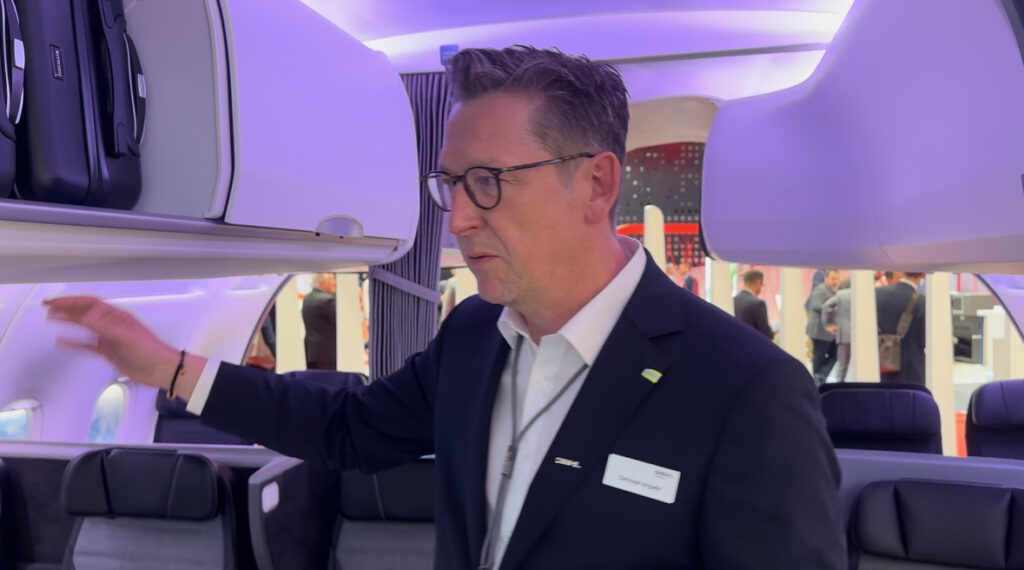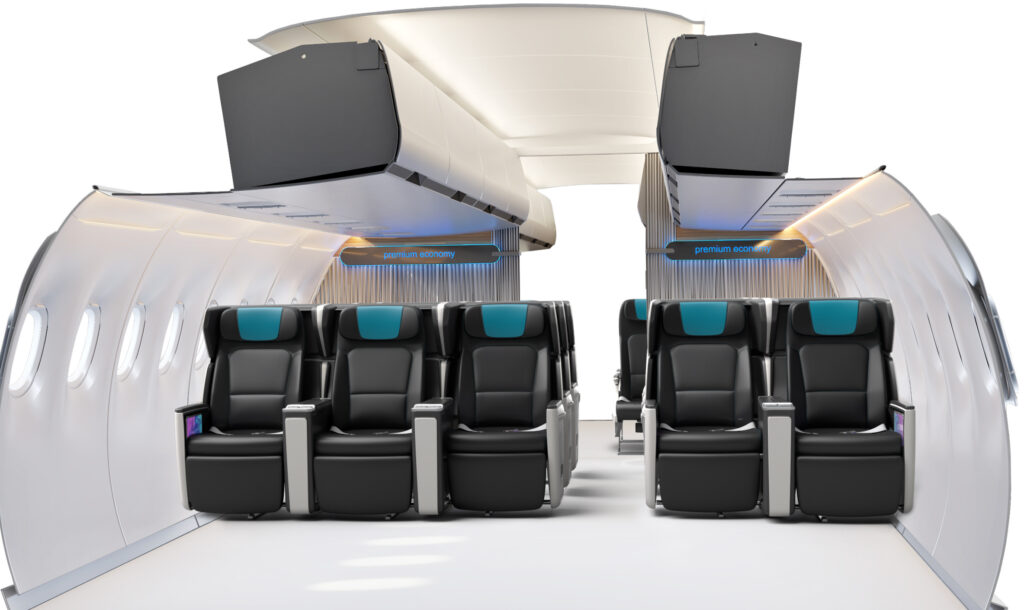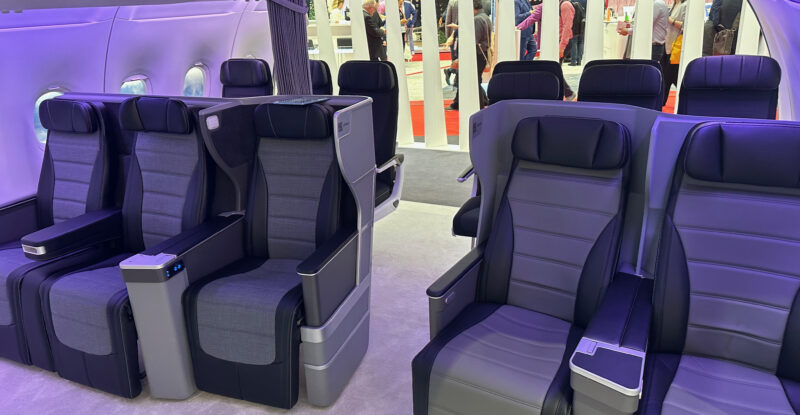 In 2021, Diehl Aviation and HAECO Cabin Solutions inked a strategic commercial agreement to jointly deliver a wide range of aircraft cabin projects, including bespoke installations, as an integrated interiors supplier. Fast forward to this month’s Aircraft Interiors Expo (AIX) in Hamburg and the fruit of their labor was on display in the form of a new premium cabin concept for single-aisle aircraft.
In 2021, Diehl Aviation and HAECO Cabin Solutions inked a strategic commercial agreement to jointly deliver a wide range of aircraft cabin projects, including bespoke installations, as an integrated interiors supplier. Fast forward to this month’s Aircraft Interiors Expo (AIX) in Hamburg and the fruit of their labor was on display in the form of a new premium cabin concept for single-aisle aircraft.
Shown only in renderings before, Diehl brought a mock-up of the cabin concept to AIX to demonstrate how — by reimagining a space traditionally filled with 2-2-configured recliners — the pair can tick a few key boxes: enhance passenger comfort and privacy, grow airline yields, and improve the eco-credentials of the premium cabin space on narrowbody aircraft.
Central to their concept is an asymmetric configuration featuring HAECO’s unique staggered-angled hybrid Eclipse seats in a five-abreast layout that staggers the two aisle seats a few inches back from the window and in turn takes the occupants’ shoulders out of alignment with their neighbour.

A five-abreast configuration was on display, but a more classic four-abreast premium layout is also on offer. In the five-abreast layout, passengers do not sit exactly behind each other as usual, but rather slightly staggered. Image: Mary Kirby
The cabin also features Diehl’s state-of-the-art cabin lighting, ECO lightweight partitions, and, importantly, Diehl’s Enlarged Bin which doubles the amount of space for carry-on bags, ensuring that the additional passengers accommodated by this five-abreast layout have stowage space.
Because of the capacity of the bins, airlines have the option of simply installing them on one side of the cabin — moved inboard above the seat triples — while adopting smaller bins on the other side or indeed removing them completely, a configuration that creates a “high ceiling feeling for the passenger”, Christoph Brigadir, Diehl’s manager product strategy & cabin concepts CoE Retrofit/BFE, explained to Runway Girl Network at AIX.

By removing the bin above the seat double (of the five-abreast configuration) Diehl has created more space and the feeling of a wider cabin.
A lot of thought has gone into this integration project. For instance, Diehl changed the philosophy of its loudspeaker systems, removing and substituting them with a new lightweight invisible Panel Loudspeaker, which it says offers “a significantly higher quality than conventional membrane speakers”.
Moreover, explained Brigadir:
What makes our enlarged bin so unique is how we attach the enlarged bin to the aircraft structure. We use a kind of frame. The frame itself is attached to the aircraft structure. And every system, like the PSU, the lights, air distribution, and other systems, are attached to the frame itself.
Even the bin is attached to the frame so once you want to remove [the bin] and substitute it with other parts [such as a different bin], just lose some screws, and you can remove the entire part and put in whatever you want. The PSU remains in the same position.
By integrating the bins in this “quick snap” fashion, airlines can also easily retrofit their aircraft in the future, he added, whilst “the ceiling remains the same, the sidewall remains the same.” This creates a more sustainable retrofit solution because “it’s not necessary to scrap the other parts.”

The overhead bin can be easily replaced, largely without disturbing the other parts. Image: Mary Kirby
Densified cabins can both improve an airline’s bottom line and its sustainability credentials. But it’s rare in industry to hear anyone claim that a denser product also equates to a better passenger experience. Referencing the five-abreast layout, specifically, HAECO Cabin Solutions president Doug Rasmussen reckons that “this is one of those few times when we can actually say with confidence that we’re improving the passenger experience to be better.”
“In that five-abreast and the stagger in the angle, you improve privacy, and you improve comfort in moving that seat into the zero-G position,” he told RGN. That’s because the seats, which are enclosed at the rear by a fixed backshell, recline through a cradling incline motion without interfering with the passenger in the next row, while providing significant seat depth and thigh support (a key consideration for taller passengers).
“If you’re in a traditional recliner style seat and that seat is fully reclined, it is impossible to get out without disturbing that passenger. Here, the person can stay seated and you can exit,” noted Rasmussen.
“From a passenger perspective you get an improved product,” he continued, “while at the same time, from an airline perspective, having the benefit of some increased density which has a positive revenue impact. So, I think it hits on both ends of those two spectrums. It’s not an either or. It’s not ‘hey we’re going to do densification and degrade the passenger experience.’
“You get densification but you improve the passenger experience. And I think you also see from the cabin and the work that the Diehl team has done with the transition aisle and the overhead bins and the PSUs that it is a well-integrated product.”

Five abreast could be positioned as premium economy or simply as a reimagined first or business class. Image: HAECO Cabin Solutions
Indeed, the cabin concept is nothing like your author has ever seen before. But there’s also an important accessibility story here, as the aisle seat armrests are designed to easily accommodate the transfer of a wheelchair passenger.
“Part of what we looked at when we were doing the development of the seat was that kind of a transfer. My father was disabled so I have a particular interest in this,” confided Rasmussen, noting that the armrest of the aisle seats retract to the same level as the seat bottom, making a transfer “about as easy as you could possibly hope for in that type of scene”.
And if, as the US DOT has promised, persons with reduced mobility will ultimately be able to stay in their own mobility devices on board — and innovations such as Air4All take flight — Rasmussen said he is “confident” that the design can be tweaked to facilitate such.









